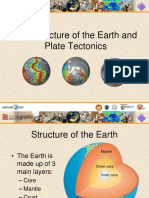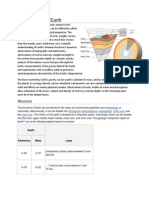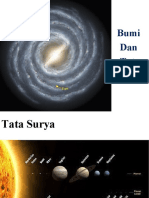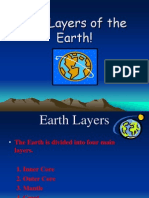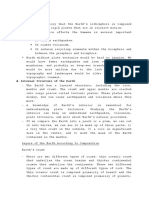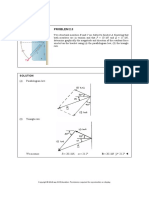An Outer Silica-Rich, Solid Crust, A Highly Viscous Mantle Liquid Outer Core That Is Much Less Viscous Than The Mantle, and A Solid Inner Core
An Outer Silica-Rich, Solid Crust, A Highly Viscous Mantle Liquid Outer Core That Is Much Less Viscous Than The Mantle, and A Solid Inner Core
Uploaded by
samihaz02Copyright:
Available Formats
An Outer Silica-Rich, Solid Crust, A Highly Viscous Mantle Liquid Outer Core That Is Much Less Viscous Than The Mantle, and A Solid Inner Core
An Outer Silica-Rich, Solid Crust, A Highly Viscous Mantle Liquid Outer Core That Is Much Less Viscous Than The Mantle, and A Solid Inner Core
Uploaded by
samihaz02Original Description:
Original Title
Copyright
Available Formats
Share this document
Did you find this document useful?
Is this content inappropriate?
Copyright:
Available Formats
An Outer Silica-Rich, Solid Crust, A Highly Viscous Mantle Liquid Outer Core That Is Much Less Viscous Than The Mantle, and A Solid Inner Core
An Outer Silica-Rich, Solid Crust, A Highly Viscous Mantle Liquid Outer Core That Is Much Less Viscous Than The Mantle, and A Solid Inner Core
Uploaded by
samihaz02Copyright:
Available Formats
The interior of the Earth is divided into layers based on chemical and physical properties.
The
Earth has an outer silica-rich, solid crust, a highly viscous mantle, and a core comprising a liquid
outer core that is much less viscous than the mantle, and a solid inner core.
Working from the centre of the Earth out we have:
The inner core is a primarily solid sphere about 1220 km in radius situated at Earth's center.
Based on the abundance of chemical elements in the solar system, their physical properties,
and other chemical constraints regarding the remainder of Earth's volume, the inner core is
believed to be composed primarily of a nickel-iron alloy, with small amounts of some unknown
elements.
The temperature is estimated at 5,000-6,000 degrees Celsius and the pressure to be about 330
to 360 GPa (which is over 3,000,000 times that of the atmosphere!)
The liquid outer core is 2300 km thick and like the inner core composed of a nickel-iron alloy
(but with less iron than the solid inner core).
Iseismic and other geophysical evidence indicates that the outer core is so hot that the metals
are in a liquid state.
The mantle is approximately 2,900 km thick and comprises 70% of Earth's volume. (the core
makes up about 30% of Earth's volume, with the outer crust [where we live] <1%!!).
The mantle is divided into sections based upon changes in its elastic properties with depth.
In the mantle, temperatures range between 500-900 degrees Celsius at the upper boundary
with the crust to over 4,000 degrees Celsius at the boundary with the core.
Due to the temperature difference between the Earth's surface and outer core, and the ability
of the crystalline rocks at high pressure and temperature to undergo slow, creeping, viscous-
like deformation over millions of years, there is a convective material circulation in the mantle
(mantle convection cells). Hot material rises up as mantle plumes (like a lava lamp!), while
cooler (and heavier) material sinks downward to be reheated and rise up again. We shall see
that this process is very important for plate tectonic motion
The outer most layer is the crust - this is the most familiar to us as it is where we live.
The distinction between crust and mantle is based on chemistry, rock types and seismic
characteristics.
- Presenter: Ask the students to guess what the most abundant element in the earths crust
is..they may be surprised to learn that it is actually Oxygen (46.6% Oxygen; 27.7% Silica;
8.1% Aluminum; 5.0% Iron; 3.6% Calcium; 2.8% Sodium; 2.6% Potassium; 2.1% Magnesium;
plus trace elements)
You might also like
- Structure of The EarthDocument21 pagesStructure of The EarthKaren DarilaNo ratings yet
- Earth and Life Science SHS 5.1 Overview of The Layers of Earth PDFDocument17 pagesEarth and Life Science SHS 5.1 Overview of The Layers of Earth PDFHally BebbsNo ratings yet
- Peeling The Earth Like An Onion : Earth Composition - Geology Books for Kids | Children's Earth Sciences BooksFrom EverandPeeling The Earth Like An Onion : Earth Composition - Geology Books for Kids | Children's Earth Sciences BooksNo ratings yet
- Underworld Meg Cabot Chapter1Document7 pagesUnderworld Meg Cabot Chapter1samihaz02100% (1)
- STPM Physics Chapter 17 Electromagnetic InductionDocument5 pagesSTPM Physics Chapter 17 Electromagnetic InductionChris Lau100% (1)
- Unveiling Earths Hidden LayersDocument22 pagesUnveiling Earths Hidden LayerssofiacassleighevangelistaNo ratings yet
- Session 1Document46 pagesSession 1Shimaa MohammedNo ratings yet
- Sci10 UNIT II Lesson 1Document26 pagesSci10 UNIT II Lesson 1Hezil Mae MancaoNo ratings yet
- Topic03_RockCycle Earth Internal Structure_9b2f94c13d6fcd52cf1a2b8d64c8800aDocument24 pagesTopic03_RockCycle Earth Internal Structure_9b2f94c13d6fcd52cf1a2b8d64c8800aalialharrasi993No ratings yet
- CIVE 1207 ENGINEERING GEOLOGY 2ADocument35 pagesCIVE 1207 ENGINEERING GEOLOGY 2AMohamedNo ratings yet
- Module 3.1 Earth StructureDocument4 pagesModule 3.1 Earth Structure7A 09 Dika Ridho AfriantaNo ratings yet
- Earth's InteriorDocument22 pagesEarth's InteriorAngel PerrerasNo ratings yet
- 1 1 Internal Structure of The EarthDocument20 pages1 1 Internal Structure of The EarthAndrea Gayle ArmedillaNo ratings yet
- What Is GeologyDocument5 pagesWhat Is GeologyJavier VillegasNo ratings yet
- 1.1 Internal Structure of The EarthDocument20 pages1.1 Internal Structure of The EarthLawrence AnDrew FrondaNo ratings yet
- 1.1 Internal Structure of the EarthDocument20 pages1.1 Internal Structure of the EarthLawrence AnDrew FrondaNo ratings yet
- The Structure of The Earth and Plate TectonicsDocument79 pagesThe Structure of The Earth and Plate TectonicsHyres Almerina AlturasNo ratings yet
- Structure of The Earth: From Wikipedia, The Free EncyclopediaDocument6 pagesStructure of The Earth: From Wikipedia, The Free EncyclopediaAnupam0103No ratings yet
- Earth Structure and DynamicsDocument18 pagesEarth Structure and DynamicsTimothyNo ratings yet
- Layers - of - The - Earth - PPT Filename - UTF-8''1. Layers of The EarthDocument15 pagesLayers - of - The - Earth - PPT Filename - UTF-8''1. Layers of The EarthRenz RazonNo ratings yet
- EarthDocument3 pagesEarthsaineeshNo ratings yet
- Earths LayersDocument33 pagesEarths LayersFebe SodsodNo ratings yet
- Layers of The Earth NotesDocument15 pagesLayers of The Earth Notesjhohanna talaNo ratings yet
- Earth Science AssignmentDocument7 pagesEarth Science AssignmentOFFICE OF THE CLERK OF COURT ILOILO CITYNo ratings yet
- Layers of The EarthDocument8 pagesLayers of The EarthSachin .VNo ratings yet
- 8th - Earth's Layers, Systems & SpheresDocument12 pages8th - Earth's Layers, Systems & SpheresCarolina LozanoNo ratings yet
- Group 1Document15 pagesGroup 1Adefehinti AfolabiNo ratings yet
- Plate Tectonics and Boundaries and Internal Structure of EarthDocument2 pagesPlate Tectonics and Boundaries and Internal Structure of EarthI Need Some SleepNo ratings yet
- Lecture-1 1Document2 pagesLecture-1 1lizakim13003No ratings yet
- Structure of The Earth's InteriorDocument16 pagesStructure of The Earth's InteriorAnupal BordoloiNo ratings yet
- Earth CompositionDocument2 pagesEarth CompositionoisidroNo ratings yet
- Hand-Outs-Earths-Internal-StructureDocument2 pagesHand-Outs-Earths-Internal-StructureJed Emerson M. KomiyamaNo ratings yet
- Interior of Earth Lyst4569Document12 pagesInterior of Earth Lyst4569logictrack639No ratings yet
- The Layers of The EarthDocument34 pagesThe Layers of The Earthmyrrdane100% (1)
- Heat From The Earths InteriorDocument4 pagesHeat From The Earths InteriorMikaella LandritoNo ratings yet
- Geology Powerpoint Earth Layers 1Document26 pagesGeology Powerpoint Earth Layers 1ynnorenzmariemendozaNo ratings yet
- Mr. Williams Layers of The Earth Guided NotesDocument42 pagesMr. Williams Layers of The Earth Guided NotesFe Pakias Gullod100% (1)
- About The MantleDocument3 pagesAbout The MantleCj QueñanoNo ratings yet
- Easc 216 - Lecture 2Document26 pagesEasc 216 - Lecture 2jerryduru35No ratings yet
- 3.-GeosphereDocument16 pages3.-GeosphereEgo sum CatholicaeNo ratings yet
- Structure of The EarthDocument15 pagesStructure of The EarthMaricel Aguilar CellsNo ratings yet
- Layers of The EarthDocument14 pagesLayers of The Earthapi-256832303No ratings yet
- The Structure of The EarthDocument3 pagesThe Structure of The EarthQuennie JanePolidoNo ratings yet
- EarthDocument4 pagesEarthNocteLuna PearlmaniaNo ratings yet
- Bumi Dan Tata SuryaDocument41 pagesBumi Dan Tata SuryafereddyyNo ratings yet
- Structure of the EarthDocument8 pagesStructure of the Earthfayaz276045No ratings yet
- Layers of The EarthDocument3 pagesLayers of The EarthANNA BABONNo ratings yet
- The Structure of The Earth and Plate TectonicsDocument44 pagesThe Structure of The Earth and Plate TectonicsNeal Lorenzo CastilloNo ratings yet
- Geology ReportDocument8 pagesGeology ReportLowel Jay DegamonNo ratings yet
- Overview of The Layers of EarthDocument14 pagesOverview of The Layers of EarthDiana Rose PascuaNo ratings yet
- G10 Cycle 1 Earth and SpaceDocument27 pagesG10 Cycle 1 Earth and SpaceATHENA GABRIELLE NAGAÑONo ratings yet
- Earths InteriorDocument64 pagesEarths InteriorBuuye ChNo ratings yet
- Week 6-7 Learnings Module - 2Document3 pagesWeek 6-7 Learnings Module - 2leothejet09No ratings yet
- Earth's LayersDocument16 pagesEarth's Layersrlo101No ratings yet
- I. Plate TectonicsDocument16 pagesI. Plate TectonicsChristian GanganNo ratings yet
- Layers of The EarthDocument29 pagesLayers of The EarthfloridohannahNo ratings yet
- Our Dynamic EarthDocument4 pagesOur Dynamic EarthPaterNo ratings yet
- Layers of The EarthDocument2 pagesLayers of The Earthtorebsuico100% (1)
- Internal Composition of The EarthDocument1 pageInternal Composition of The Earthhatdog dakoNo ratings yet
- Structure of The EarthDocument7 pagesStructure of The EarthVardan AdityaNo ratings yet
- Layers of EarthDocument31 pagesLayers of EarthPrincess Raychel Delos AngelesNo ratings yet
- Closer To The EdgeDocument1 pageCloser To The Edgesamihaz02No ratings yet
- History of Textile Production in BangladeshDocument3 pagesHistory of Textile Production in Bangladeshsamihaz02No ratings yet
- Bangladesh TextileDocument4 pagesBangladesh Textilesamihaz02No ratings yet
- Forward MarketDocument25 pagesForward Marketsamihaz02No ratings yet
- Phone Hacking Scandal Ethics ArticleDocument2 pagesPhone Hacking Scandal Ethics Articlesamihaz02No ratings yet
- Viral Marketing, Viral Advertising, orDocument1 pageViral Marketing, Viral Advertising, orsamihaz02No ratings yet
- BkashDocument3 pagesBkashsamihaz02No ratings yet
- Internship Report On Decision Analysis of The Project RGPF' OF Renata LimitedDocument1 pageInternship Report On Decision Analysis of The Project RGPF' OF Renata Limitedsamihaz02No ratings yet
- 16 5 Relative Acceleration PDFDocument24 pages16 5 Relative Acceleration PDFSindhu BabuNo ratings yet
- Analysis of HVDC ConvertersDocument51 pagesAnalysis of HVDC ConvertersVivek Kumar0% (1)
- 5G Channel ModelDocument102 pages5G Channel ModelLamiae SqualiNo ratings yet
- SGU PHD TestDocument27 pagesSGU PHD TestSushant WaghmareNo ratings yet
- Level 5 Advanced Technician Diploma in Electrical and Electronic Engineering v2Document71 pagesLevel 5 Advanced Technician Diploma in Electrical and Electronic Engineering v2D Gihan Perera75% (4)
- Coordinate Geometry (S3) 2019-20Document3 pagesCoordinate Geometry (S3) 2019-20極光、No ratings yet
- Question Paper CodeDocument3 pagesQuestion Paper CodeGokul NathNo ratings yet
- Sample Questions For FINAL ExamDocument8 pagesSample Questions For FINAL ExamTausif AhmedNo ratings yet
- General Mathematics11 - Q1 - Module3Document29 pagesGeneral Mathematics11 - Q1 - Module3julius84% (49)
- NEE - 1102 - Experiment 5 - Baetiong Van Verald C.Document9 pagesNEE - 1102 - Experiment 5 - Baetiong Van Verald C.Stephen VisperasNo ratings yet
- Analog To Digital Converter: 1 Binary FormatDocument15 pagesAnalog To Digital Converter: 1 Binary FormatAliceLazarNo ratings yet
- On Systems of Linear Diophantine Equations PDFDocument6 pagesOn Systems of Linear Diophantine Equations PDFhumejiasNo ratings yet
- Chapter 10 Infinite SeriesDocument33 pagesChapter 10 Infinite SeriesanirudhNo ratings yet
- Solution Homework Chapter 2Document10 pagesSolution Homework Chapter 2Joe HaddadNo ratings yet
- PosterDocument1 pagePosterthedeaconsNo ratings yet
- This Study Resource Was: Blood Spatter Lab: Angle of ImpactDocument6 pagesThis Study Resource Was: Blood Spatter Lab: Angle of ImpactSierra CallowayNo ratings yet
- SHS 100x6Document1 pageSHS 100x6Yavor AlexievNo ratings yet
- Top 40 Fill in Blank QA Computer FundamentalsDocument4 pagesTop 40 Fill in Blank QA Computer FundamentalshalumsonaNo ratings yet
- Core JAVA Interview Questions and AnswersDocument62 pagesCore JAVA Interview Questions and AnswersRaghunath DayalaNo ratings yet
- Share of Wallet in Retailing The Effects of Customer SatisfactionDocument10 pagesShare of Wallet in Retailing The Effects of Customer SatisfactionFrank XieNo ratings yet
- Multidimensional Mellin Transforms Involving I-Functions of Several Complex VariablesDocument6 pagesMultidimensional Mellin Transforms Involving I-Functions of Several Complex VariablesinventionjournalsNo ratings yet
- 26 2 Cauchy Riemann Eqn CNFML Map PDFDocument12 pages26 2 Cauchy Riemann Eqn CNFML Map PDFClinton PromotingJesusNo ratings yet
- Pengaruh Pelatihan Dan Lingkungan Kerja Terhadap Kinerja KaryawanDocument10 pagesPengaruh Pelatihan Dan Lingkungan Kerja Terhadap Kinerja KaryawanferdiantiNo ratings yet
- Chap 1 Probability Theory and CQDocument64 pagesChap 1 Probability Theory and CQrafidmagnus2004No ratings yet
- Ai Lab ManualDocument51 pagesAi Lab ManualAbhinav DesaiNo ratings yet
- Top School in IndiaDocument56 pagesTop School in IndiaedholecomNo ratings yet
- Chapter 5 A D and D 23232Document7 pagesChapter 5 A D and D 23232juber mullaNo ratings yet
- Punching Shear Tests On Column FootingsDocument23 pagesPunching Shear Tests On Column FootingsRaju SkNo ratings yet
- ALL C ProgramsDocument235 pagesALL C Programscnufrnd100% (1)
















